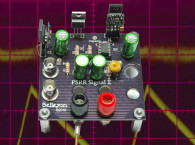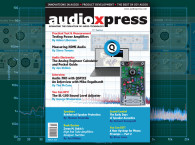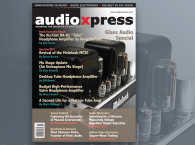 About 10 years ago, with my audio system in disrepair, I started a mission to design and build a new preamp. This was a third-generation design, as my first preamp was a tube RIAA unit built in the early 1980s. This one was to be solid state and the first step was to make “the best” power supply. In the December 2008 issue of audioXpress, Ed Simon concluded a five-part article on power supplies and cleaning of AC power lines with “The best solution is a well-designed power supply in the audio gear itself.”
About 10 years ago, with my audio system in disrepair, I started a mission to design and build a new preamp. This was a third-generation design, as my first preamp was a tube RIAA unit built in the early 1980s. This one was to be solid state and the first step was to make “the best” power supply. In the December 2008 issue of audioXpress, Ed Simon concluded a five-part article on power supplies and cleaning of AC power lines with “The best solution is a well-designed power supply in the audio gear itself.”Power supplies have been around since 1800 when Alessandro Volta invented the forerunner to an electric battery. How hard can it be to achieve “the best solution”? Having designed power supplies in the past, and having read a lot through the years, I set a goal of an affordable supply with really solid voltage regulation.
Before inexpensive voltage regulator ICs were widely available (late 1960s), audio gear often had hum, fizz, crackle, and other noises. Well-designed amplification systems typically used differential stages and/or push–pull outputs that canceled hum by summing it with its inverted self to add to zero at the output. Some products had a hum adjustment potentiometer to allow hum to be manually nulled by increasing the volume and turning the pot until hum was minimized. However, even the best audio equipment had some hum at high volume.
As you know, voltage regulators are everywhere in modern audio gear. Open a DAC, a preamp, a mixer, a CD player, MP3 player, cell phone, computer, music server and you’ll find them. Complex mixed analog+digital ICs often have them built in, and the venerable LM78xx, the LM317, and their more modern descendants often grace the pages of this periodical. The primary function of these devices is to take anything you feed them, AC, DC, lightening, or firecrackers, and turn it into clean, quiet, perfectly flat DC voltage that’s constant for every output current load condition, under every temperature, humidity, atmospheric pressure, and political upheaval circumstance.
Voltage regulators have many specifications such as output current, noise, drop-out, input ripple rejection, and dynamic load transient response. This article examines a search for a true measurement of ripple rejection, which is also called power supply rejection ratio (PSRR).
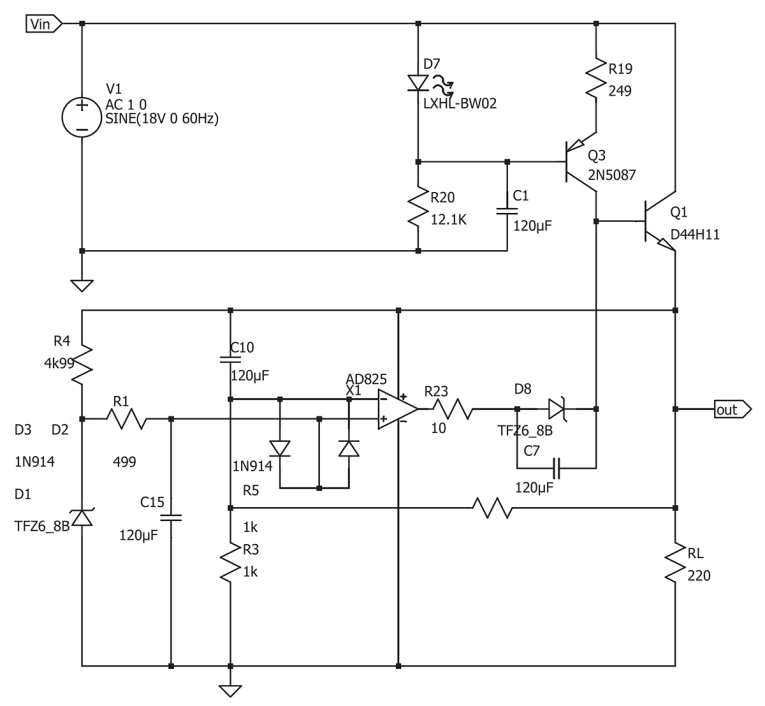
Ripple Rejection
Ripple rejection is somewhat of a misnomer, named for the ripple that appears on a linear transformer rectifier-filter-type raw power supply. An ideal regulator, if one existed, would reject not only the inherent ripple from this, it would reject a digital spike, a sub–1 Hz slow thermal variation, and so forth. The most common cases are at the low-frequency end as power line ripple (normally a saw-tooth wave at twice the power line frequency of 50 Hz or 60 Hz).
At the high-frequency end, a switched mode power supply (SMPS) can produce spikes from tens of kilohertz to megahertz. Also, more recent switching audio amplifiers have transient noise as non-periodic digital noise source due to pulse width modulation (PWM) inside the amplifier. Recently, a manufacturer of Class D power amps told me high-performance voltage regulators made a “significant performance impact in our product.” High-frequency, uncorrelated supply noise can make its way to places like a clock circuit, increasing jitter and thus causing data errors in a DAC or ADC.
Thus, high ripple rejection across a wide bandwidth can improve the fidelity and integrity of traditional mains-to-transformer powered audio, SMPS powered audio and Class D PWM type audio. This includes equipment used by both the recording and playback sides of the industry.
IC op-amps often have a specification of more than 100 dB power supply rejection. If you look further at the datasheet to PSRR vs. frequency, rejection rolls off rapidly as frequency increases. It may decrease by 10 or 20 dB at a few kilohertz. Thus, variations in the raw power supply can make their way to the audio path through an op-amp. Discrete, single-ended designs are potentially worse yet, as they don’t have a way to null supply variations like a differential topology does.

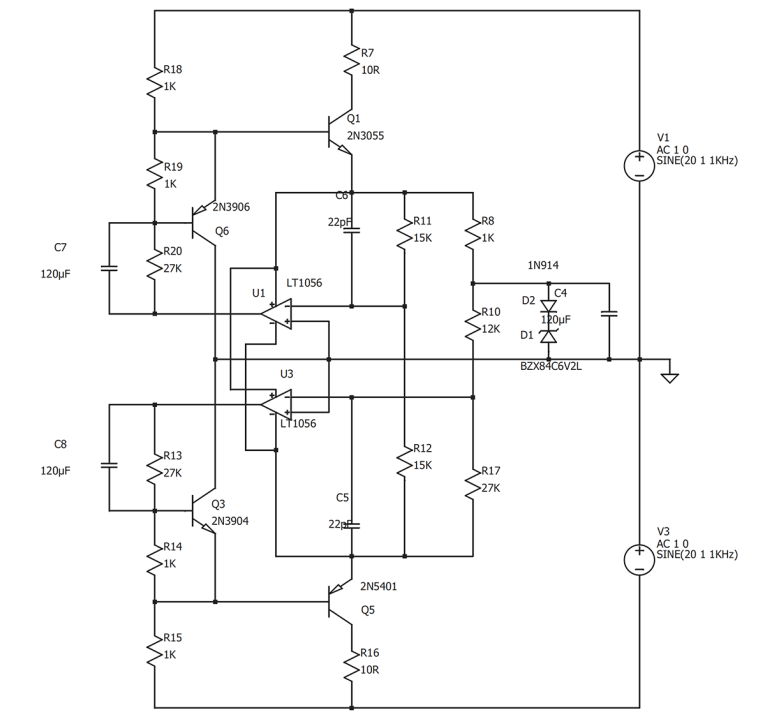
Regulator Designs
So back to the search for “good regulation,” I spent a month or so researching various regulator designs including super regulator designs like those presented by Walt Jung, one by John Roberts in a preamp in a 1985 issue of Audio Amateur, a 2007 variation of the Jung regulator from Zetex (now called Diodes, Inc.), and a great historical analysis of regulator evolution by Tangentsoft. These are known as series regulators because the regulator is in series with the load current, vs. a shunt regulator which regulates by having a fixed load current that is steered either to the load or shunted to ground.
While I later looked at shunt regulators, they are not a topic in this article. Interestingly, the John Roberts regulator circuit was not discussed as being anything extraordinary. Described by Roberts as “my simple op-amp/transistor regulated power supply,” it, in fact, has all the facets of a true super regulator (SR), with both the error amplifier and voltage reference bootstrap powered by the regulated output. It also has tracking dual polarity outputs, supplying negative and positive 15 V, and preceded the publication of Jung’s bootstrapped regulator by 15 years.
Given that a SR’s error amplifier drives the output device and is simultaneously powered by that same output voltage, there must be a voltage level translation to keep the op-amp’s output voltage within its power rails. This is accomplished in the Roberts supply with clever transistor biasing, while the Jung SR uses a Zener diode on the op-amp’s output. Figure 1 shows the schematics for the Jung design.
There are disadvantages to the Jung design, including its physical size due to several large electrolytic capacitors, its start-up issues as detailed in Jung’s 2000 Audio Electronics article (see Resources), its necessity of a ground connected voltage reference, and its limited output current. In my analysis of the AD797 version, there was also an instability problem within a range of output current for the specific breadboard tested (see Figure 2).
Roberts’ design (see Figure 3) is a dual-tracking regulator where the negative half establishes a regulated output and the positive half follows by inverting it. The Jung/Didden design uses a current source to drive the output transistor, with excess current pulled away by the loop control amplifier. A Zener diode shifts the loop amplifier output higher than its power supply, allowing it to be powered by the regulated Vout.
The Roberts design uses a voltage follower scaled by a resistor divider. The 1 kΩ resistor from Vin couples ripple to the base of Q7 output transistor so, while I never built this design, I suspect it has relatively high ripple. Note that the original design used a TL072 dual op-amp, where this one shows two LT1056A, which are similar JFET input op-amps.
As the general consensus in DIY postings favored the Jung version, I built one and began experimenting with ways to better implement the level shift. Ultimately, I figured out that a JFET’s gate-to-source voltage could be used to do the level shift and, when combined with a shunt voltage reference, allow the entire regulator control loop and reference to float. This gives the possibility of a low component count, low noise, high current, high voltage bootstrapped regulator. In 2010, I filed for a US patent for this design and it was granted in 2012.
Referring to Figure 4 (taken from the patent) notice how only the drain of J1 and collector of Q1 are connected to the raw input supply. The drain and collector are both high impedance nodes and all the other regulation circuitry is within the control loop. Unlike the other designs, there are no other paths for ripple (or any sort of undesired signal) to reach the regulated output. Thus, this design should be capable of very high ripple rejection. With this verbose introduction, we now embark on a long and perilous journey to measure ripple rejection.
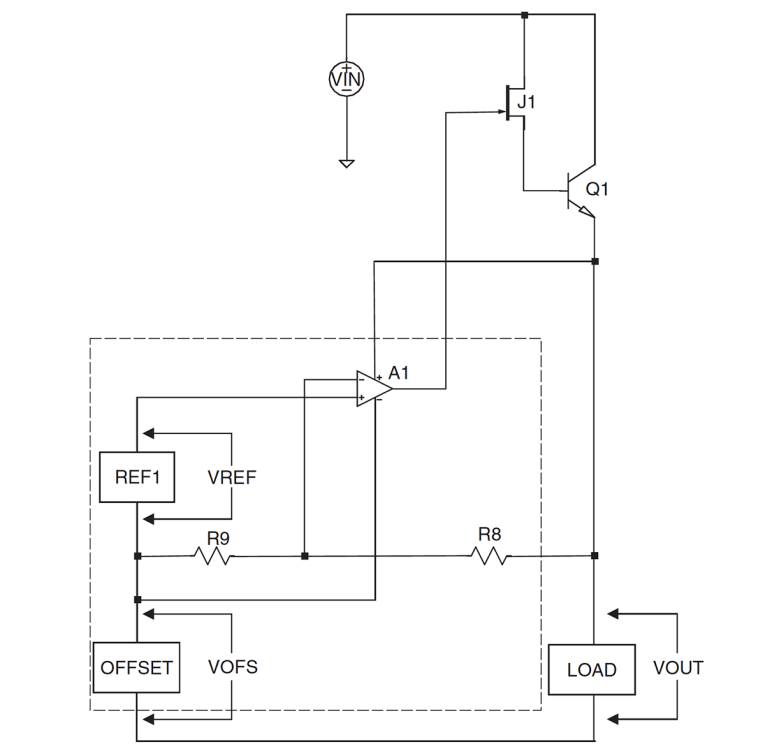
Measuring Ripple Rejection
There are several important regulator specifications: line regulation, noise, output impedance, load transient response, and load regulation. The goal is to find out if the circuit of figure 4 has slayed the line regulation dragon. Line regulation is also called power supply rejection ratio (PSRR) and ripple rejection. The latter phrase seems the most descriptive and will be used here.
A voltage regulator is fundamentally a power transformation device that ideally should replace any sort of incoming power—AC, DC, pulses, noise, whatever, with a pure, constant DC voltage that can supply any current requested by a load. The question we want to resolve is how close can a regulator come to that ideal as it relates to rejecting the non-DC portion of incoming power?
Semiconductor manufacturers use expensive automated test systems to test ripple rejection. In the early 1980s, these systems were really good at testing digital components and not so good at testing analog parameters. One of the primary objectives was keeping test times low, and component specifications were sometimes tailored to make devices look as good as possible.
For example, power supply rejection was tested by making two DC measurements at two different input voltages and taking the ratio of the change in Vout to the change in Vin. This is a very lightweight test that allows a datasheet to look really good on the line for ripple rejection. It gives some indication of ripple rejection at low frequencies, thus of its ability to clean power line ripple coming from a rectified and filtered AC source (see Figure 5).
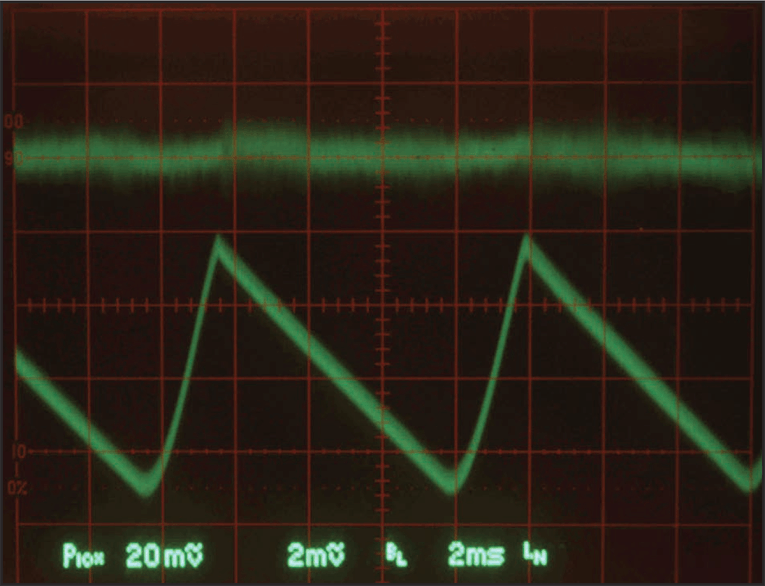
As we know, things get more complicated as frequency goes up. In the mid-1980s, the advent of consumer CD players introduced audio systems containing digital signals in the same chassis and on the same board as analog signals. Connection traces became more critical and power supply ripple rejection too, at frequencies well beyond 50 Hz or 60 Hz. Voltage regulators became more than a power transformation... when used strategically they also became a way to isolate different functional sections of a circuit system. And ripple rejection across a wider frequency band became much more important.
Automated test systems used by semiconductor manufacturers (e.g., those made by Teradyne) naturally have improved their equipment to do more thorough characterization of various parameters across frequencies. Small companies and DIYers don’t have the cash for a multi–million dollar machine, or maybe even for the electrical service to power it. There are other alternatives such as those from Audio Precision that are “more affordable,” in the range of a few tens of thousands of US dollars.
This is still not an option for many, so what’s a bright designer to do?
A typical analytic approach to bench test ripple rejection across a broad frequency band is to impose a sine wave at various frequencies onto a DC voltage. Thus, a power source of DC + sine wave is set as regulator Vin, with conditions that the lowest point of the sine wave is above the drop-out voltage of the regulator, and the highest point is below the maximum DC of the supplying input source and below the maximum regulator Vin. This seems easy enough, right? In the intervening 10 years since I first began measuring ripple rejection I’ve tried numerous ways to generate a source signal good enough to span zero to 200 kHz and give accurate results for a regulator with exceptionally good performance. Some were okay and some not so much.
In the second part of this two-part article, we’ll take a look at them. aX
This article was originally published in audioXpress, May 2019.
Resources
W. Jung, “Low-Noise Power for Analog Circuits,” Electronic Design, June 1997.
W. Jung, “Improved Positive/Negative Regulators,” Audio Electronics, April 2000.
B. Lowe, Jr., “Voltage Regulator Using Depletion Mode Pass Driver and Boot-Strapped, Input Isolated Floating Reference,” US Patent 8,294,440 B2,
www.belleson.com/download/Belleson_Pat_8294440.pdf
J. H. Roberts, “Preeminent Preamp,” Audio Amateur, No. 3, 1985.
I. Sibson, “AN51 Precision voltage regulation for ultra-low noise applications,” Application Notes, Zetex Semiconductors (now Diodes, Inc.),
www.diodes.com/assets/App-Note-Files/zetex/an51.pdf
Ed Simon, “2400 W of Clean AC Power,” audioXpress, December 2008.
W. Young, “Op-Amp Based Linear Regulators,” Tangentsoft,
https://tangentsoft.net/elec/opamp-linreg.html
 About the Author
About the AuthorBrian Lowe is founder and principal engineer at Belleson LLC. His audio circuit design experience dates to 1971, when he designed a reverb unit using a ceramic phono cartridge, four ball point pen springs, a model car hub cap, a transistor amplifier kit, and a speaker. In the 1980s, he was author of an article in Issue 1 of Glass Audio called “A Self-Bias Servo for Push Pull Amps,” and in 1984 he designed a diamond tester. He received US patent 8294440 in 2012 for a novel voltage regulator. He’s a proud father of two, and spouse of a very tolerant and patient wife.
Read Part 2 of this article here.



